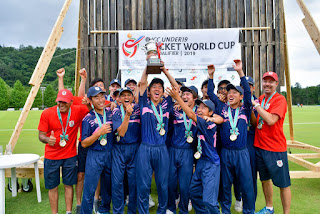Why the Japanese changed all cricketing terms into their language except 'Howzaat'?
By K.R. Nayar
Japanese cricketers have coined cricketing terms in their language, and on one occasion I got to hear them using it during a match in the UAE. Cricket enthusiast Shyam Bhatia, watching the devotion of the Japanese to the game, decided to donate cricket kits regularly to promote the game there. Japan Cricket Association’s CEO Naoki Alex Miyaji believes that since the Japanese are known for their hard work, they will make a mark in international cricket one day. Read the story below...

Japan won the ICC qualifier to participate in the 2020 Under-19 World Cup
In November 2000, the Japanese cricket team came to the UAE to play in the Asian Cricket Council trophy. I was eager to see them play cricket because most people believed the Japanese and Chinese would never play cricket. The Japanese are well known for their innovation in every field, and hence I was keen to see what innovation they would bring to cricket to create an identity of their own. True enough, they did it.
I met Naoaki Saida, a Japanese team member who had
studied in England and speaks fluent English. I learned from him that
they had extended their innovative skills by coining new cricket terms in
Japanese.
I asked him what ‘tata’ and ‘nagara’ meant since I’d heard them
shout out these two terms repeatedly on the field when a batsman hit for a
catch or ran for a quick single. Saida told me that a catch was called ‘tata’
and a throw was called ‘nagara’. While they were batting I had also heard them
shout ‘eaio’, which Saida explained that it meant ‘well played' in Japanese.
Then Saida revealed that the only term they had not changed was
‘Howzaat’, and he also gave me the reason for that with a smile: “If we coin a
new term for Howzaat, the umpire will not understand that, and we could
have difficulties in getting a decision from the umpire.”
Cricket enthusiast and businessman Shyam Bhatia, who loves to encourage all cricketers who play with enthusiasm for the game, was impressed with the devotion by the Japanese towards the game. Since Bhatia has helped many countries in the world that are striving to make their presence in cricket, he decided to focus on Japan as well. Right away he donated 250 sets of cricket kits, each set containing four bats, four wickets, 12 balls, and batting tees, to Japan as part of his Cricket for Care charity.
 |
| Shyam Bhatia with Naoki Alex Miyaji |
Then in 2008, I met Naoki Alex Miyaji, Chief Executive Officer of the Japanese Cricket Association (JCA), another genuine enthusiast of the game. His enthusiasm to popularise the game, which he fell in love with at the age of ten when he went to London, could be felt. During our conversation, he remarked: “We are not physically big or fast and strong. Our biggest strength is discipline, hard work, and team spirit. We Japanese are known for hard work and we will soon make a mark in international cricket.”

Cricket for Smiles organised to bring smiles to children with Bhatia's kit
Bhatia has so far dispatched more than 100s of kits and T-shirts to Japan. “I regularly send them cricket equipment since I love their enthusiasm to play the game. I was planning to send them more but that's when Covid-19 happened,” said Bhatia, who was extremely pleased when in Japan qualified for the 2020 ICC Under-19 World Cup in South Africa.



Interesting piece. Hard work is an asset in whatever one chooses to do. I can foresee some Jap cricketing champs.
ReplyDelete